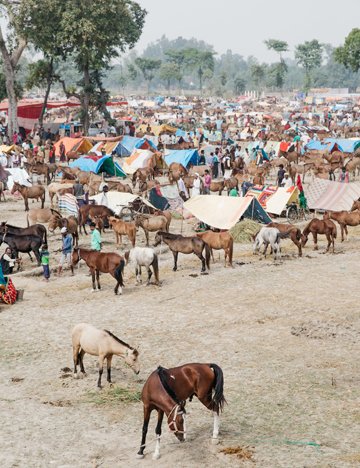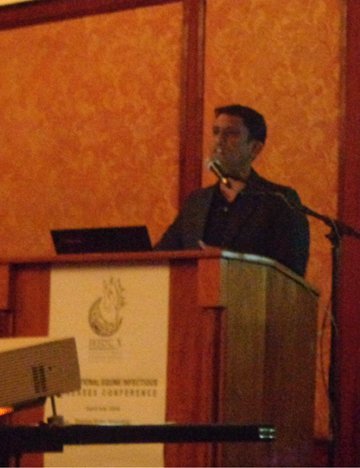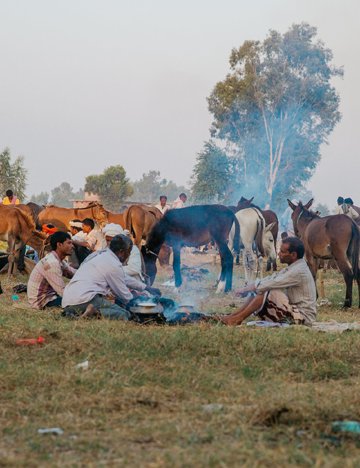Equine Fairs - a fountain of opportunities
Equine fairs provide Brooke with an opportunity to learn more about the communities that attend them. One project of in the field research took Dr Dinesh Mohite from Brooke India to Argentina to present the team's findings.
Equine fairs, where thousands or horses, donkeys and mules are grouped together, provide Brooke with an opportunity to learn more about the communities that attend them as well as offering advice and training.
As the summer draws to an end in the U.K, India’s Equine Fairs start popping up all over the country, where owners and traders come from far and wide to buy and sell horses, donkeys and mules. Thousands of animals can be found at each fair, who, once sold, go on to work mainly in brick kilns, but also in construction, agriculture or purely as a family’s main mode of transport. These fairs, with so many animals all in one place, offer Brooke India an opportunity to interact with owners, offer training and experience to local health providers, and provide a treatment service.
However, in the last few years the team have realised that these environments also provide an excellent opportunity to study diseases that, if tackled properly, could improve the health of large groups of animals at the same time. One of the most recent projects with the Qalandar Community uncovered some surprising results, which ended up taking Dr Dinesh Mohite from Brooke India to the 10th International Equine Infectious Diseases Conference (IEIDC) in Buenos Aires, Argentina, to present the team’s findings.
It was the first time Brooke India had presented at this conference and their research was different from most attendees, as instead of lab research, theirs was conducted in the field. Attendees included The World Organisation for Animal Health (OIE), scientists and vet students from all over the world, and other animal charities including the Donkey Sanctuary, and the Animal Health Trust.

The Qalandar Community are a nomadic group from Northern India that, despite travelling less in modern days, still commit to living in small community groups with little access to modern resources. They rear mules by breeding horse mares with a donkey stallion, then earn a living by selling them on to individual owners, often at equine fairs.
A common issue for animals in these communities has been spontaneous abortion (miscarriages). Brooke India assumed that this was due to Surra, a blood disease that is known to be exist in this area, but decided to conduct blood tests to find out more accurate results. Surra also causes fever, weakness and fatigue which lead to weight loss, anaemia and even neurological signs, where the animal displays unusual behaviour. If left untreated, it can be fatal in some animals. In partnership with the National Research Centre on Equines, India, the team took blood samples from 113 animals and then sent them for analysis to a laboratory.
The results that came back were surprising. There was, as suspected, a high prevalence of Surra, which can cause miscarriages, but there were three other infections that can also cause it that they had not expected to find.

There were four diseases found in the horses, donkeys and mules that were tested. One of course, was Surra, also known as Trypanosomiasis, a contagious disease transmitted by biting flies. Surra can be prevented by having cleaner living conditions for animals, and grazing animals at the times of the day when there fewer flies around. This is particularly important during and after the rainy season, as the flies breed in standing water. Communities also rub natural repellents on their animals like garlic paste, and use smoke to drive away flies.
The second disease, found in many of the animals, was Piroplasmosis. This is also known as ‘malaria of equines’. It causes a range of signs alongside miscarriage including fever and weight loss.
Also, six cases of equine herpes virus (EHV-1) were identified. EHV-1 is a highly contagious viral infection which causes miscarriage and breathing problems. It can also lead to more serious conditions. Because it spreads quickly, it can cause all of a community’s animals to get sick at the same time, causing widespread suffering and having a massive economic effect on the owners’ livelihoods.
Lastly, the most surprising disease found was Japanese Encephalitis, a viral infection that is zoonotic, meaning it can be transmitted between animals and humans, in this case by mosquitos. It is unlikely that it can be transmitted between equines and humans, but there is a small chance it can travel via other animals. People who are infected usually have flu-like symptoms but it can cause disability or even death. Recently the Indian government has implemented a disease control programme to reduce the number of people infected.

Dr Mohite explained that this has completely changed the way Brooke India tackles infection in the Qalandar communities and others that they interact with at Equine Fairs. The team now need to think about how to understand all the diseases that could be present, diagnose and treat them effectively. If not controlled, animals die and people in these communities, who are already struggling with poverty, lose vital income. Dr Mohite said:
“This study has highlighted the importance of definitive diagnosis, especially in migratory communities like the Qalandar Community. The problem is, accurate tests are not commonly available in these regions, so there is a need for cheaper more accurate tests. Ultimately, prevention is better than cure, and that is what Brooke India is striving to achieve.”
Brooke India are currently changing the way they approach their work at Equine Fairs, bringing it in line with our new strategy. Rather than just providing treatment and advice, they are focusing on running workshops and training local health providers, working towards a more sustainable future for the fairs where animals are healthy and happy without intervention from Brooke.
You can read the full abstract presented at IEIDC on the Journal of Equine Veterinary Science website
